fog light Citroen DS5 HYBRID4 2015 1.G Owner's Manual
[x] Cancel search | Manufacturer: CITROEN, Model Year: 2015, Model line: DS5 HYBRID4, Model: Citroen DS5 HYBRID4 2015 1.GPages: 436, PDF Size: 12.72 MB
Page 16 of 436
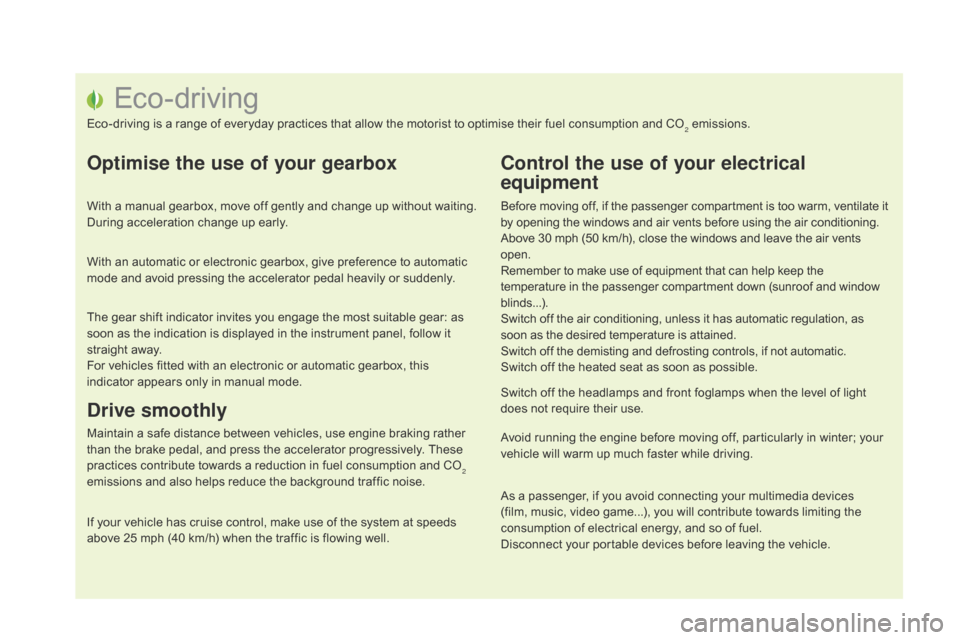
Eco-driving
Eco-driving is a range of everyday practices that allow the motorist to optimise their fuel consumption and CO2 emissions.
Optimise the use of your gearbox
With a manual gearbox, move off gently and change up without waiting.
During acceleration change up early.
With an automatic or electronic gearbox, give preference to automatic
mode and avoid pressing the accelerator pedal heavily or suddenly.
The gear shift indicator invites you engage the most suitable gear: as
soon as the indication is displayed in the instrument panel, follow it
straight away.
For vehicles fitted with an electronic or automatic gearbox, this
indicator appears only in manual mode.
drive smoothly
Maintain a safe distance between vehicles, use engine braking rather
than the brake pedal, and press the accelerator progressively. These
practices contribute towards a reduction in fuel consumption and CO
2
emissions and also helps reduce the background traffic noise.
If your vehicle has cruise control, make use of the system at speeds
above 25 mph (40 km/h) when the traffic is flowing well.
control the use of your electrical
equipment
Before moving off, if the passenger compartment is too warm, ventilate it
by opening the windows and air vents before using the air conditioning.
Above 30 mph (50 km/h), close the windows and leave the air vents
open.
Remember to make use of equipment that can help keep the
temperature in the passenger compartment down (sunroof and window
blinds...).
Switch off the air conditioning, unless it has automatic regulation, as
soon as the desired temperature is attained.
Switch off the demisting and defrosting controls, if not automatic.
Switch off the heated seat as soon as possible.
Switch off the headlamps and front foglamps when the level of light
does not require their use.
Avoid running the engine before moving off, particularly in winter; your
vehicle will warm up much faster while driving.
As a passenger, if you avoid connecting your multimedia devices
(film, music, video game...), you will contribute towards limiting the
consumption of electrical energy, and so of fuel.
Disconnect your portable devices before leaving the vehicle.
Page 22 of 436
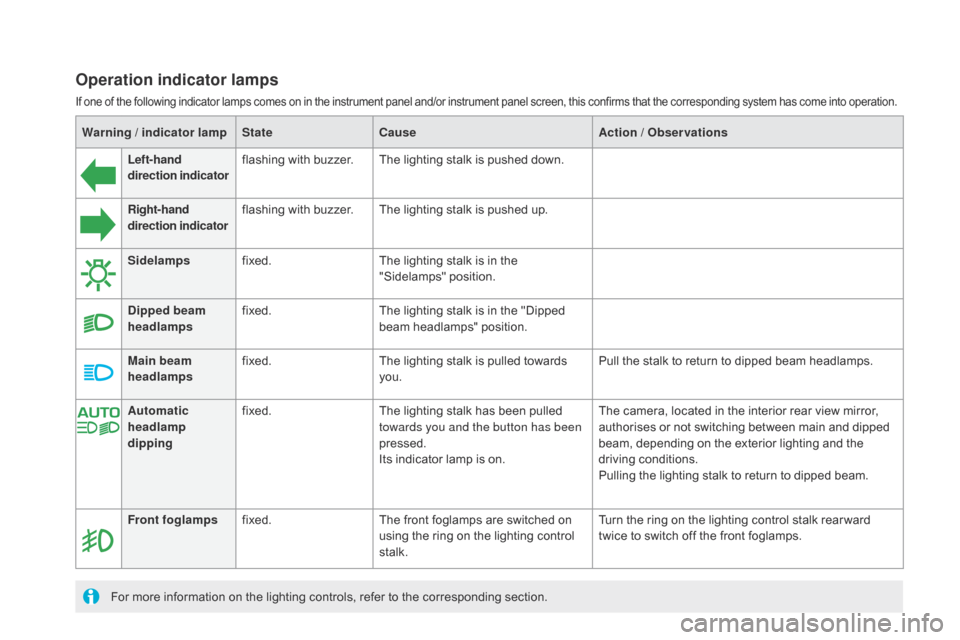
DS5_en_Chap01_controle-de-marche_ed01-2015
Warning / indicator lampStatecau seAction / Observations
Left-hand
direction indicato rflashing with buzzer.
The lighting stalk is pushed down.
Right-hand
direction indicator flashing with buzzer.
The lighting stalk is pushed up.
Sidelamps fixed. The lighting stalk is in the
"Sidelamps" position.
di
pped beam
headlamps fixed.
The lighting stalk is in the "Dipped
beam headlamps" position.
Main beam
headlamps fixed.
The lighting stalk is pulled towards
you. Pull the stalk to return to dipped beam headlamps.
Front foglamps fixed. The front foglamps are switched on
using the ring on the lighting control
stalk. Turn the ring on the lighting control stalk rear ward
twice to switch off the front foglamps.
For more information on the lighting controls, refer to the corresponding section. Automatic
headlamp
dipping
fixed.
The lighting stalk has been pulled
towards you and the button has been
pressed.
Its indicator lamp is on. The camera, located in the interior rear view mirror,
authorises or not switching between main and dipped
beam, depending on the exterior lighting and the
driving conditions.
Pulling the lighting stalk to return to dipped beam.
Operation indicator lamps
If one of the following indicator lamps comes on in the instrument panel and/or instrument panel screen, this confirms that the corresponding system has come into operation.
Page 127 of 436

125
DS5_en_Chap04_conduite_ed01-2015
Lane departure warning system
System which, using a camera which
recognises solid or broken lines, detects the
involuntary crossing of longitudinal traffic lane
markings on the ground.
To provide safe driving, the camera analyses
the image then, if the driver's attention drops,
triggers a warning if the vehicle drifts over a
lane marking (speed higher than 50 mph
(80 km/h)).
This system is particularly useful on motor ways
and main roads.
Activation
F Press this button, the indicator lamp comes on.
The lane departure warning system
cannot, in any circumstances replace
the need for vigilance on the part of the
driver.
deactivation
You are warned by the vibration of the driver's
seat cushion:
-
o
n the right-hand side, if the marking on
the ground has been crossed on the right,
-
o
n the left-hand side, if the marking on the
ground has been crossed on the left.
No warning is transmitted while the direction
indicator is active and for approximately
20 seconds after the direction indicator is
switched
off.
detection - Alert Operating fault
The detection may be impeded:
-
i f the markings on the ground are
worn,
-
i
f there is little contrast between the
markings on the ground and the
road surface,
-
i
f the windscreen is dirty,
-
i
n certain severe weather
conditions: fog, heavy rain, snow,
bright sunlight or direct exposure
to the sun (low sun, leaving a
tunnel,
...) and shade.
F
P
ress this button again, the
indicator lamp goes off. In the event of a fault, the indicator lamp in the
button flashes.
Contact a CITROËN dealer or a qualified
workshop.
The status of the system remains in the
memory when the ignition is switched off. It is necessary to observe the driving
regulations and to take a break every
two hours.
driving
Page 146 of 436
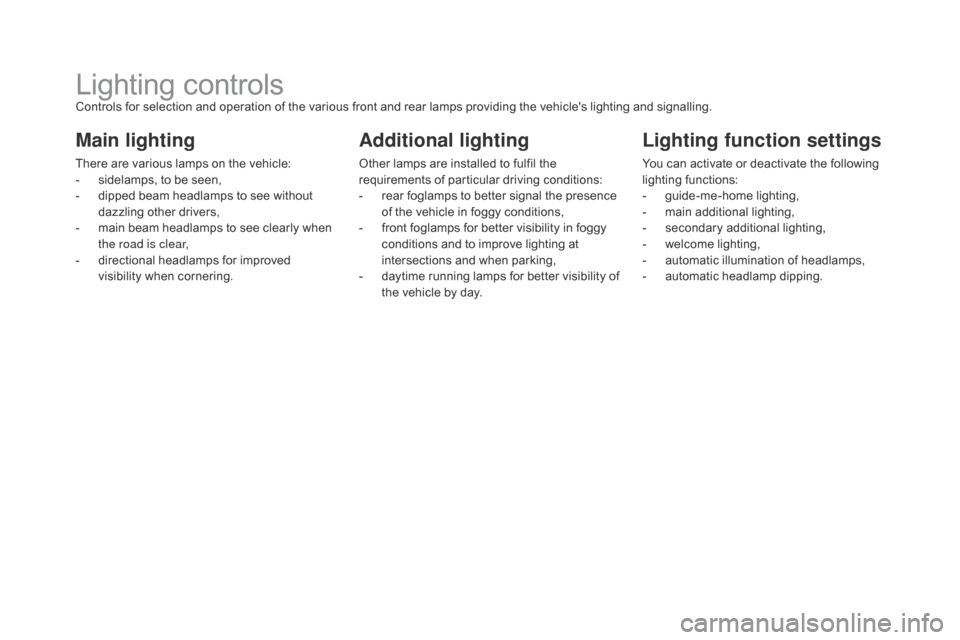
DS5_en_Chap05_visibilite_ed01-2015
Lighting controlsControls for selection and operation of the various front and rear lamps providing the vehicle's lighting and signalling.
Main lighting
There are various lamps on the vehicle:
- s idelamps, to be seen,
-
d
ipped beam headlamps to see without
dazzling other drivers,
-
m
ain beam headlamps to see clearly when
the road is clear,
-
d
irectional headlamps for improved
visibility when cornering.
Additional lighting
Other lamps are installed to fulfil the
requirements of particular driving conditions:
-
r
ear foglamps to better signal the presence
of the vehicle in foggy conditions,
-
f
ront foglamps for better visibility in foggy
conditions and to improve lighting at
intersections and when parking,
-
d
aytime running lamps for better visibility of
the vehicle by day.
Lighting function settings
You can activate or deactivate the following
lighting functions:
-
g
uide-me-home lighting,
-
m
ain additional lighting,
-
s
econdary additional lighting,
-
w
elcome lighting,
-
a
utomatic illumination of headlamps,
-
a
utomatic headlamp dipping.
Page 148 of 436
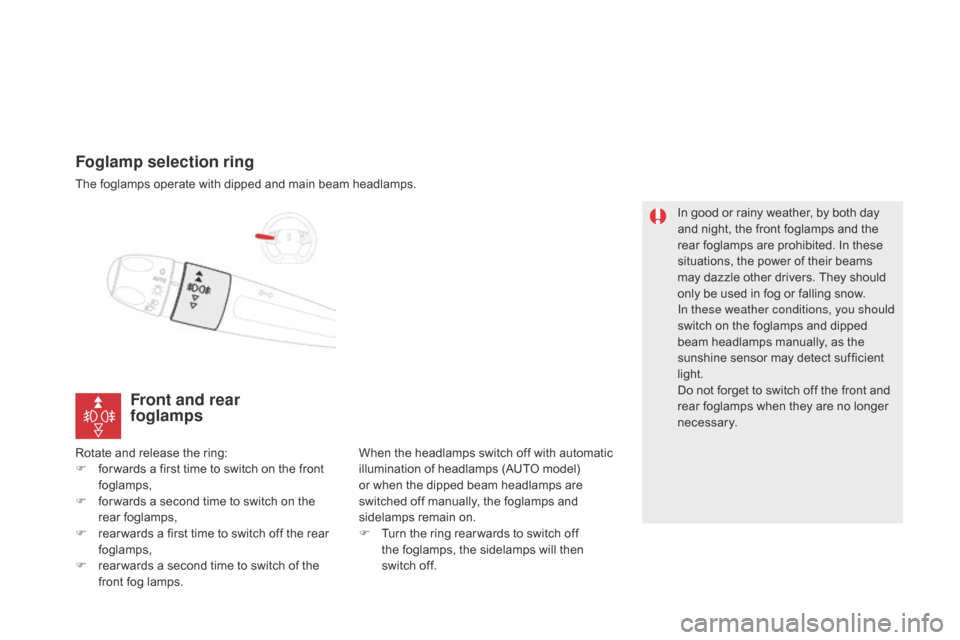
DS5_en_Chap05_visibilite_ed01-2015
Foglamp selection ring
The foglamps operate with dipped and main beam headlamps.
Rotate and release the ring:
F
f
or wards a first time to switch on the front
foglamps,
F
f
or wards a second time to switch on the
rear foglamps,
F
r
ear wards a first time to switch off the rear
foglamps,
F
r
ear wards a second time to switch of the
front fog lamps. When the headlamps switch off with automatic
illumination of headlamps (AUTO model)
or when the dipped beam headlamps are
switched off manually, the foglamps and
sidelamps remain on.
F
T
urn the ring rear wards to switch off
the foglamps, the sidelamps will then
switch off. In good or rainy weather, by both day
and night, the front foglamps and the
rear foglamps are prohibited. In these
situations, the power of their beams
may dazzle other drivers. They should
only be used in fog or falling snow.
In these weather conditions, you should
switch on the foglamps and dipped
beam headlamps manually, as the
sunshine sensor may detect sufficient
light.
Do not forget to switch off the front and
rear foglamps when they are no longer
necessary.
Front and rear
foglamps
Page 150 of 436
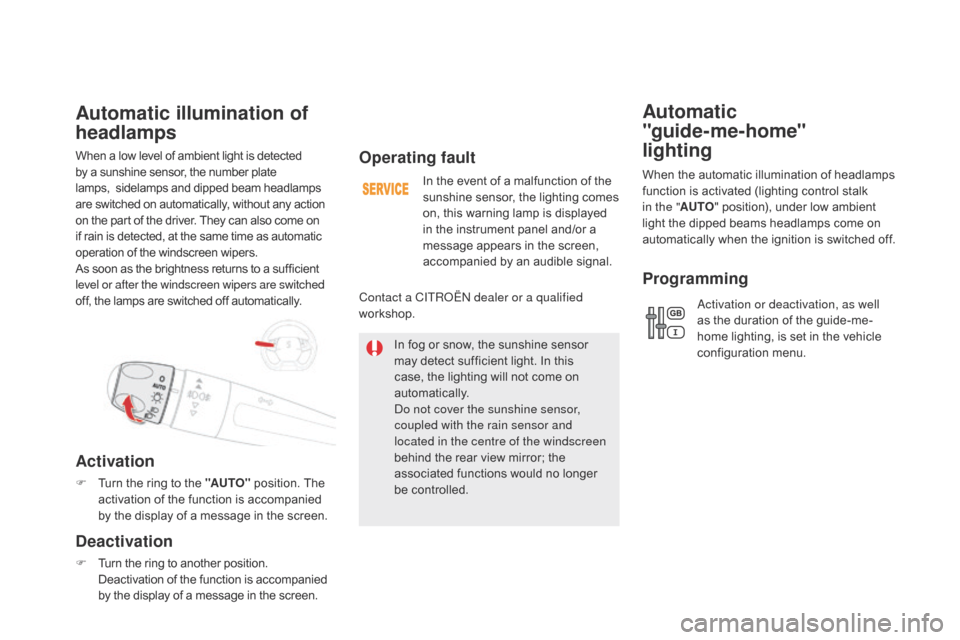
DS5_en_Chap05_visibilite_ed01-2015
When a low level of ambient light is detected
by a sunshine sensor, the number plate
lamps, sidelamps and dipped beam headlamps
are switched on automatically, without any action
on the part of the driver. They can also come on
if rain is detected, at the same time as automatic
operation of the windscreen wipers.
As soon as the brightness returns to a sufficient
level or after the windscreen wipers are switched
off, the lamps are switched off automatically.
Automatic illumination of
headlamps
Activation
F Turn the ring to the "AUTO" position. The
activation of the function is accompanied
by the display of a message in the screen.
deactivation
F Turn the ring to another position. Deactivation of the function is accompanied
by the display of a message in the screen. When the automatic illumination of headlamps
function is activated (lighting control stalk
in the "
AUTO" position), under low ambient
light the dipped beams headlamps come on
automatically when the ignition is switched off.
Operating fault
In the event of a malfunction of the
sunshine sensor, the lighting comes
on, this warning lamp is displayed
in the instrument panel and/or a
message appears in the screen,
accompanied by an audible signal.
In fog or snow, the sunshine sensor
may detect sufficient light. In this
case, the lighting will not come on
automatically.
Do not cover the sunshine sensor,
coupled with the rain sensor and
located in the centre of the windscreen
behind the rear view mirror; the
associated functions would no longer
be controlled.
Contact a CITROËN dealer or a qualified
workshop.
Programming
Automatic
"guide-me-home"
lighting
Activation or deactivation, as well
as the duration of the guide-me-
home lighting, is set in the vehicle
configuration menu.
Page 152 of 436
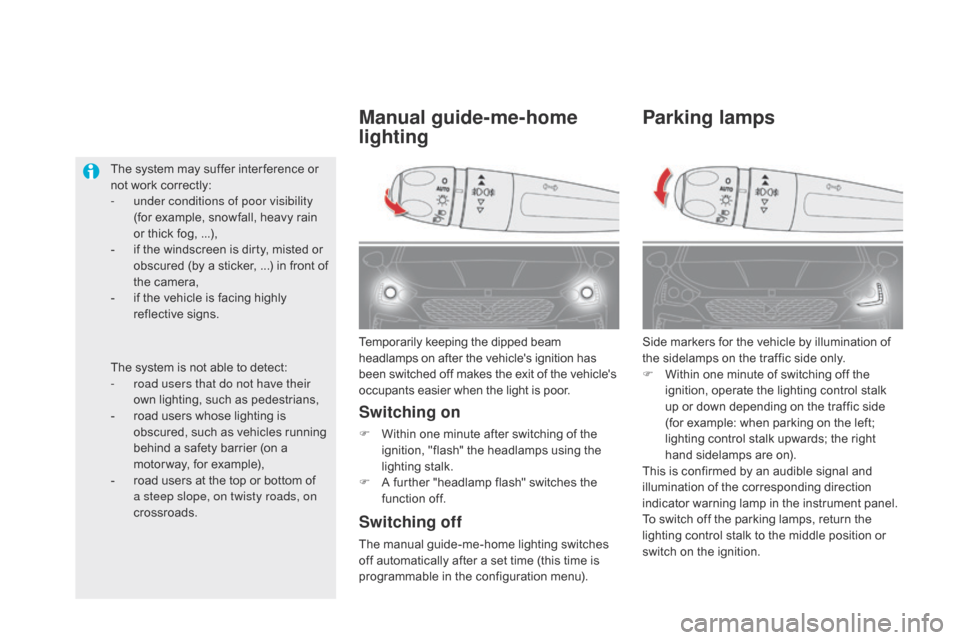
DS5_en_Chap05_visibilite_ed01-2015
Parking lamps
Side markers for the vehicle by illumination of
the sidelamps on the traffic side only.
F
W
ithin one minute of switching off the
ignition, operate the lighting control stalk
up or down depending on the traffic side
(for example: when parking on the left;
lighting control stalk upwards; the right
hand sidelamps are on).
This is confirmed by an audible signal and
illumination of the corresponding direction
indicator warning lamp in the instrument panel.
To switch off the parking lamps, return the
lighting control stalk to the middle position or
switch on the ignition.
Temporarily keeping the dipped beam
headlamps on after the vehicle's ignition has
been switched off makes the exit of the vehicle's
occupants easier when the light is poor.
Manual guide-me-home
lighting
Switching on
F Within one minute after switching of the
ignition, "flash" the headlamps using the
lighting stalk.
F
A f
urther "headlamp flash" switches the
function off.
Switching off
The manual guide-me-home lighting switches
off automatically after a set time (this time is
programmable in the configuration menu).
The system may suffer inter ference or
not work correctly:
-
u
nder conditions of poor visibility
(for example, snowfall, heavy rain
or thick fog, ...),
-
i
f the windscreen is dirty, misted or
obscured (by a sticker, ...) in front of
the camera,
-
i
f the vehicle is facing highly
reflective signs.
The system is not able to detect:
-
r
oad users that do not have their
own lighting, such as pedestrians,
-
r
oad users whose lighting is
obscured, such as vehicles running
behind a safety barrier (on a
motor way, for example),
-
r
oad users at the top or bottom of
a steep slope, on twisty roads, on
crossroads.
Page 156 of 436
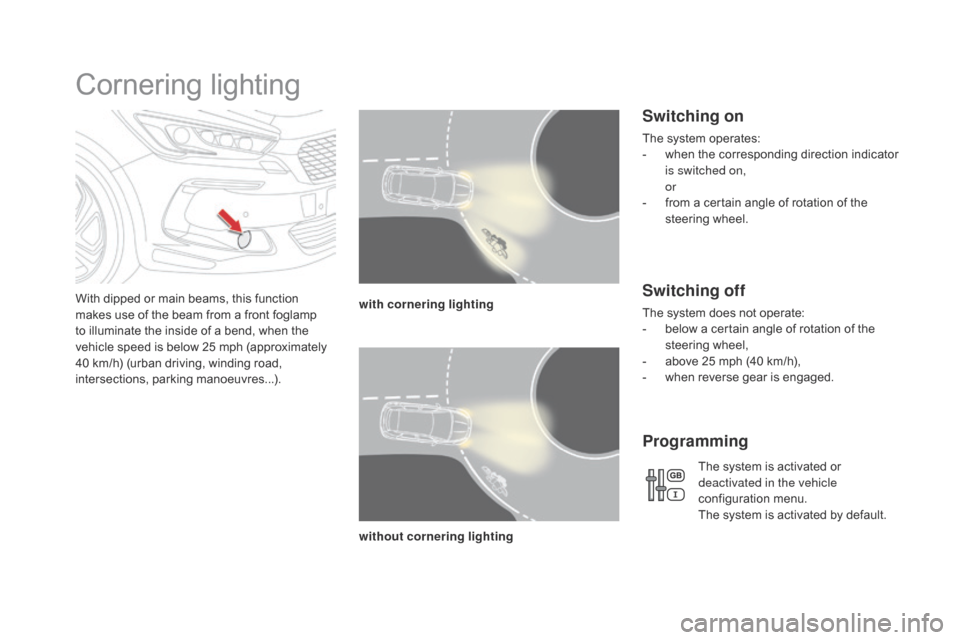
DS5_en_Chap05_visibilite_ed01-2015
Cornering lighting
With dipped or main beams, this function
makes use of the beam from a front foglamp
to illuminate the inside of a bend, when the
vehicle speed is below 25 mph (approximately
40 km/h) (urban driving, winding road,
intersections, parking manoeuvres...).with cornering lighting
without cornering lighting
Switching on
The system operates:
-
w hen the corresponding direction indicator
is switched on,
or
-
f
rom a certain angle of rotation of the
steering wheel.
Switching off
The system does not operate:
- b elow a certain angle of rotation of the
steering wheel,
-
a
bove 25 mph (40 km/h),
-
w
hen reverse gear is engaged.
Programming
The system is activated or
deactivated in the vehicle
configuration menu.
The system is activated by default.
Page 215 of 436
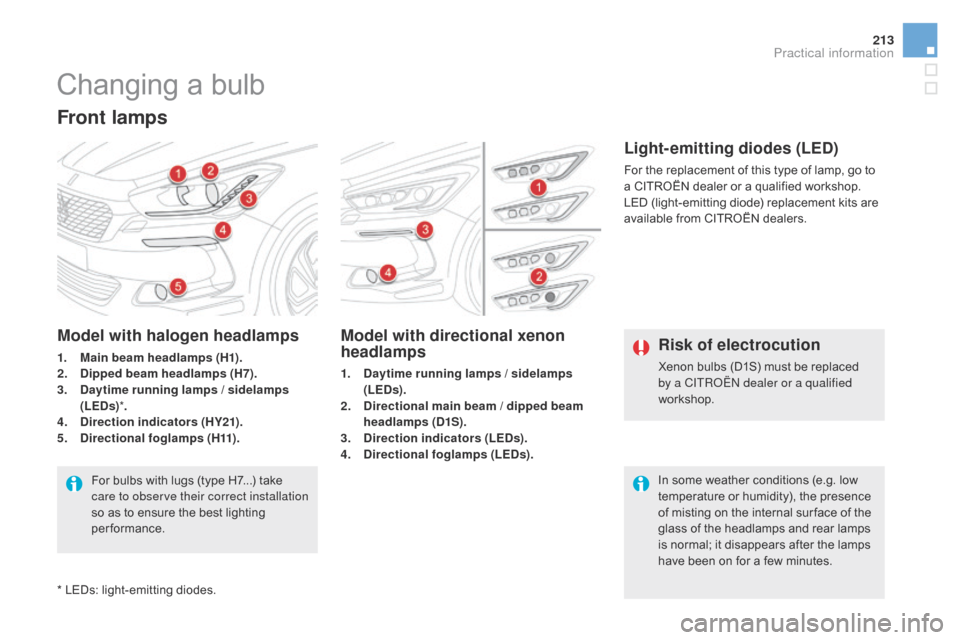
213
DS5_en_Chap08_info-pratiques_ed01-2015
Changing a bulb
Front lamps
Model with directional xenon
headlamps
1. daytime running lamps / sidelamps
(LEds ).
2.
di
rectional main beam / dipped beam
headlamps (
d1S
).
3.
di
rection indicators (LE
ds
).
4.
di
rectional foglamps (LE
ds
).
Model with halogen headlamps
1. Main beam headlamps (H1).
2. di
pped beam headlamps (H7).
3.
da
ytime running lamps / sidelamps
(LE
d s)*.
4.
di
rection indicators (HY21).
5.
di
rectional foglamps ( H11) .
For bulbs with lugs (type H7...) take
care to observe their correct installation
so as to ensure the best lighting
performance. In some weather conditions (e.g. low
temperature or humidity), the presence
of misting on the internal sur face of the
glass of the headlamps and rear lamps
is normal; it disappears after the lamps
have been on for a few minutes.Risk of electrocution
Xenon bulbs (D1S) must be replaced
by a CITROËN dealer or a qualified
workshop.
Light-emitting diodes (LEd)
For the replacement of this type of lamp, go to
a CITROËN dealer or a qualified workshop.
LED (light-emitting diode) replacement kits are
available from CITROËN dealers.
* LEDs: light-emitting diodes.
Practical information
Page 381 of 436
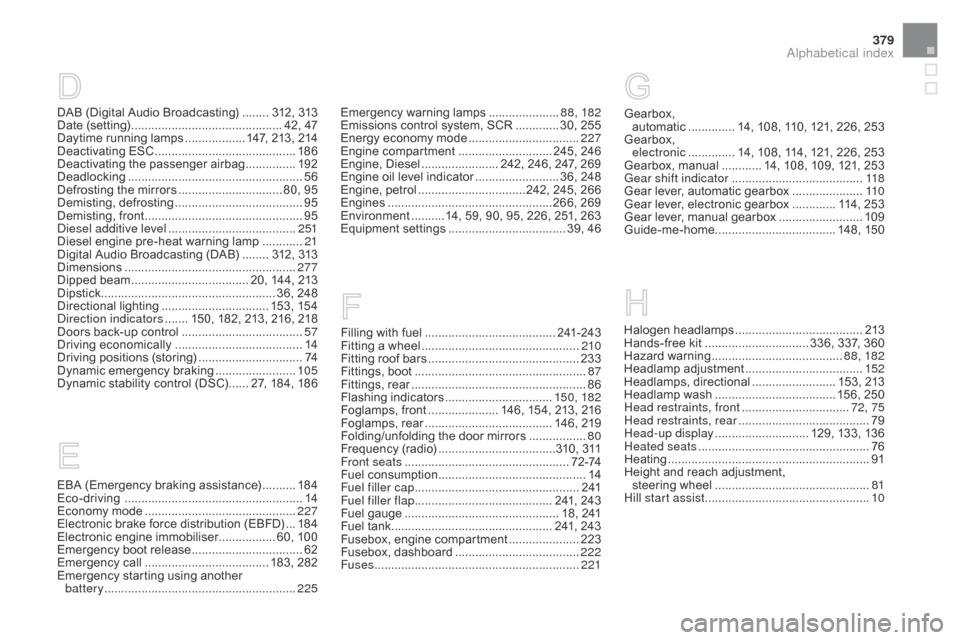
379
DS5_en_Chap12_index-recherche_ed01-2015
DAB (Digital Audio Broadcasting) ........31 2, 313
Date (setting) ............................... .............. 42, 47
Daytime running lamps
.................. 1
47, 213, 214
Deactivating ESC
.......................................... 18
6
Deactivating the passenger airbag
............... 19
2
Deadlocking
...............................
.....................56
Defrosting the mirrors
............................... 8
0, 95
Demisting, defrosting
...................................... 95
D
emisting, front
............................................... 95
D
iesel additive level
...................................... 2
51
Diesel engine pre-heat warning lamp
............21
D
igital Audio Broadcasting (DAB)
........31
2, 313
Dimensions
..............................
.....................277
Dipped beam
...............................
.... 20, 144, 213
Dipstick
................
.................................... 36, 248
Directional lighting
...............................
.153, 15 4
Direction indicators
....... 1
50, 182, 213, 216, 218
Doors back-up control
.................................... 57
D
riving economically ...................................... 14
Driving positions (storing)
...............................74
D
ynamic emergency braking
........................ 10
5
Dynamic stability control (DSC)
...... 2
7, 184, 186Filling with fuel
.......................................24
1-243
Fitting a wheel
...............................
................210
Fitting roof bars
.............................................23
3
Fittings, boot
...................................................87
F
ittings, rear
...............................
.....................86
Flashing indicators
................................ 15
0, 182
Foglamps, front
..................... 1
46, 154, 213, 216
Foglamps, rear
...................................... 1
46, 219
Folding/unfolding the door mirrors
.................80
F
requency (radio)
...................................31
0, 311
Front seats
..............................
...................7 2 -74
Fuel consumption
............................................ 14
F
uel filler cap
.................................................2
41
Fuel filler flap
......................................... 2
41, 243
Fuel gauge
.............................................. 1
8, 241
Fuel tank................................................ 241, 243
Fusebox, engine compartment
..................... 2
23
Fusebox, dashboard
..................................... 2
22
Fuses
................
.............................................221
EBA (Emergency braking assistance)
..........18
4
Eco-driving
...............................
......................14
Economy mode
...............................
..............227
Electronic brake force distribution (EBFD)
...18
4
Electronic engine immobiliser ................. 60, 100
Emergency boot release
................................. 62
E
mergency call
..................................... 1
83, 282
Emergency starting using another battery
......................................................... 2
25 Gearbox,
automatic .............. 1
4, 108, 110, 121, 226, 253
Gearbox,
electronic
.............. 1
4, 108, 114, 121, 226, 253
Gearbox, manual
............ 1
4, 108, 109, 121, 253
Gear shift indicator
....................................... 11
8
Gear lever, automatic gearbox
.....................11
0
Gear lever, electronic gearbox
............. 1
14, 253
Gear lever, manual gearbox
.........................10
9
Guide-me-home
...............................
..... 148, 150
Halogen headlamps
...................................... 2
13
Hands-free kit
..............................
. 336, 337, 360
Hazard warning
....................................... 8
8, 182
Headlamp adjustment
................................... 15
2
Headlamps, directional
......................... 1
53, 213
Headlamp wash
.................................... 1
56, 250
Head restraints, front
................................7
2, 75
Head restraints, rear
.......................................79
H
ead-up display
............................ 1
29, 133, 136
Heated seats
...............................
....................76
Heating
................
............................................91
Height and reach adjustment, steering wheel
..............................
................81
Hill start assist
.................................................10
Emergency warning lamps .....................8 8, 182
Emissions control system, SCR ............. 3 0, 255
Energy economy mode
.................................2
27
Engine compartment
............................ 2
45, 246
Engine, Diesel
....................... 2
42, 246, 247, 269
Engine oil level indicator
......................... 3
6, 248
Engine, petrol
................................ 2
42, 245, 266
Engines
..............................
...................266, 269
Environment
..........1
4, 59, 90, 95, 226, 251, 263
Equipment settings
................................... 3
9, 46
Alphabetical index